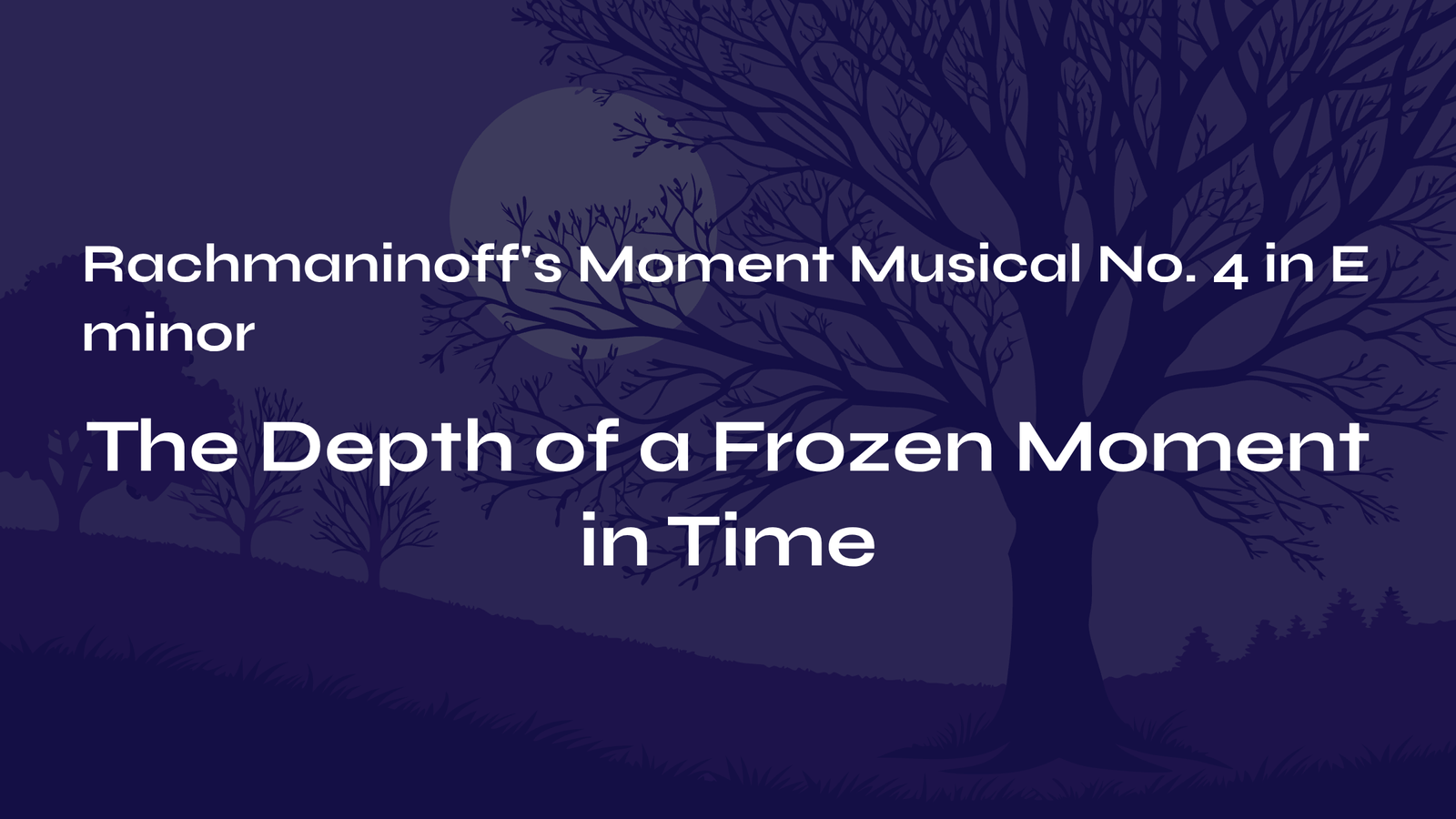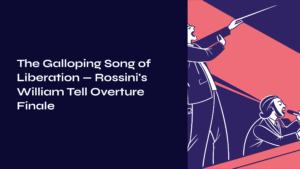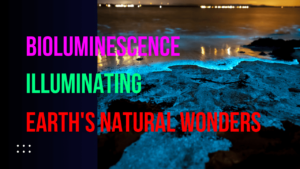Table of Contents
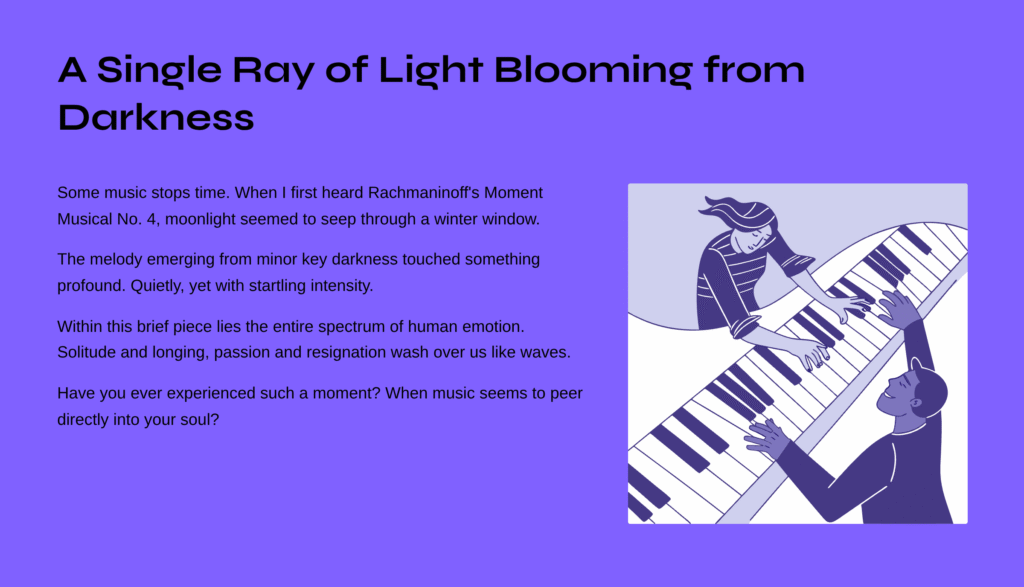
A Single Ray of Light Blooming from Darkness
Some music stops time. When I first heard Rachmaninoff’s Moment Musical No. 4, I felt as if moonlight was seeping through a window on a deep winter night. The melody emerging from the darkness of the minor key touched something profound within me—quietly, yet with startling intensity.
Within this brief piece lies the entire spectrum of human emotion. Solitude and longing, passion and resignation wash over us like waves in just a few short minutes. Have you ever experienced such a moment? When a single piece of music seems to peer directly into your soul?
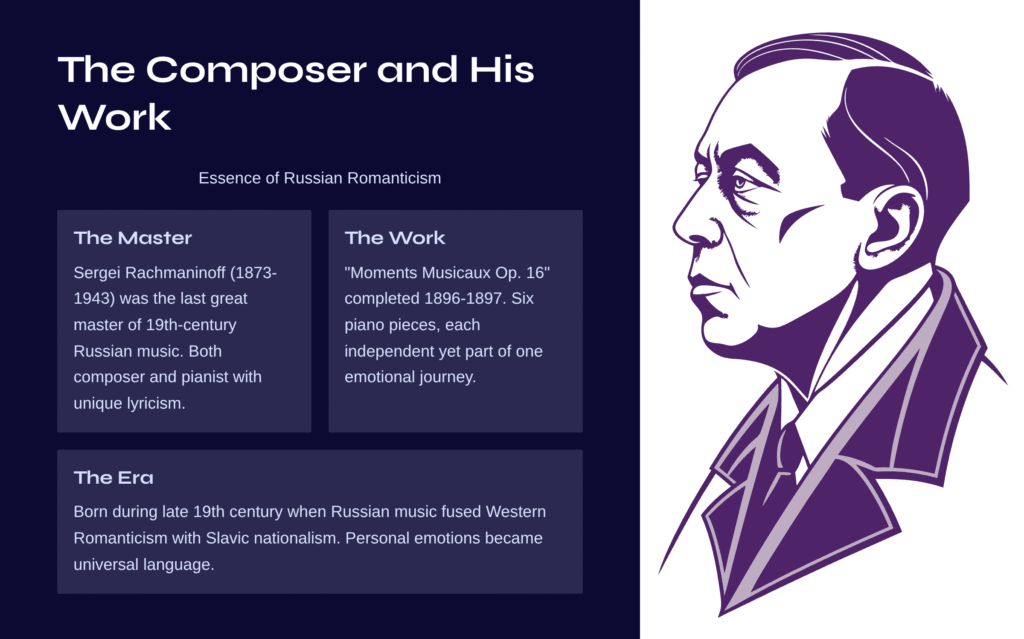
The Composer and His Work: Essence of Russian Romanticism
Sergei Rachmaninoff (1873-1943) was the last great master of 19th-century Russian music. As both composer and pianist, he possessed a unique combination of profound lyricism and technical perfection. His piano works especially embody both the vastness of the Russian steppes and the characteristic Russian melancholy.
The “Moments Musicaux Op. 16,” completed between 1896 and 1897, consists of six piano pieces. Each piece stands independently while contributing to a single emotional journey. Among them, No. 4 in E minor is considered the most dramatically contrasted and emotionally profound.
This work was born during the late 19th century, when Russian music was creating its distinctive color by fusing Western Romanticism with Slavic nationalism. Rachmaninoff demonstrated an extraordinary ability to transform personal emotions into universal musical language within this historical context.
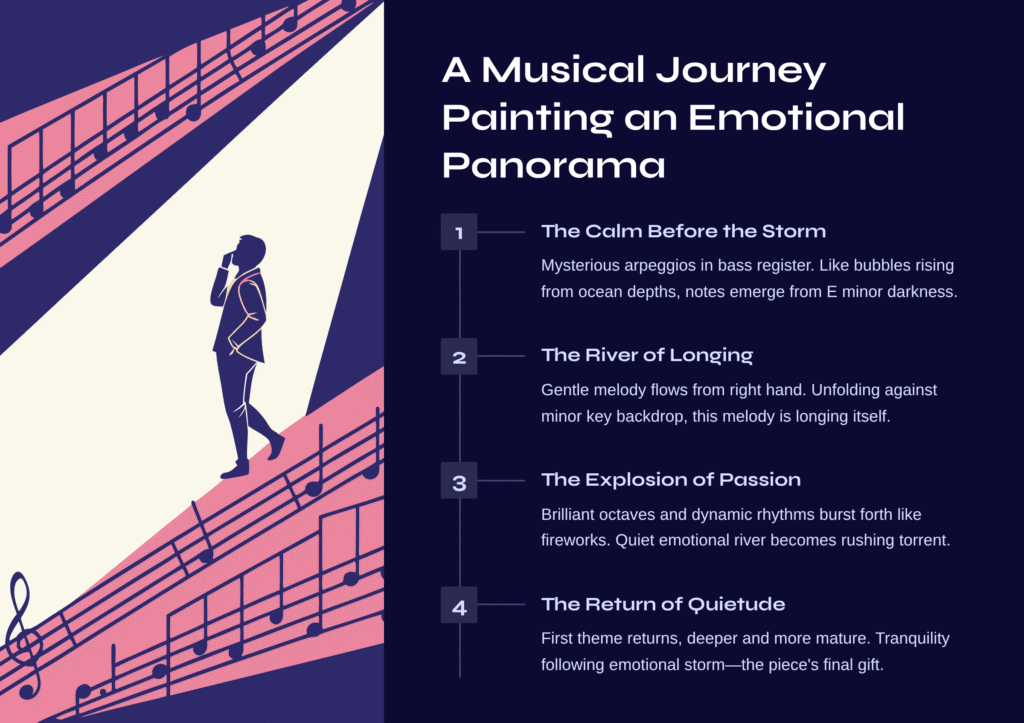
A Musical Journey Painting an Emotional Panorama
The Calm Before the Storm – Introduction
The piece begins with mysterious arpeggios in the bass register. Like bubbles rising from the ocean depths, notes emerge one by one from the darkness of E minor. This moment of stillness is not mere silence—it’s a tension that foretells something significant is about to unfold.
Listening to these first sounds created by the pianist’s fingertips, I feel a tightness in my chest. Though we don’t yet know what will begin, our hearts are already being drawn into some deep emotion.
The River of Longing – First Theme
As the introduction’s tension reaches its peak, a gentle melody flows from the right hand. This is the piece’s first theme. Unfolding against the backdrop of E minor’s darkness, this melody is longing itself.
Like memories surfacing while looking at old photographs, this melody transports us to some moment in the past. As each note connects to the next, I find myself thinking of someone dear and distant. Perhaps you feel something similar when listening to this melody?
The Explosion of Passion – Second Theme
But Rachmaninoff doesn’t let us remain in longing alone. The second theme that soon emerges reveals a completely different world. Brilliant octaves and dynamic rhythms burst forth like fireworks.
This section makes my heart race. The quiet emotional river suddenly becomes a rushing torrent. Rachmaninoff’s characteristic technical brilliance shines here. Yet this isn’t mere technical display—it’s a musical portrayal of the human drama when suppressed emotions explode in a single moment.
The Return of Quietude – Recapitulation and Conclusion
In the piece’s latter half, the first theme returns. But this time it’s different. The quietude following the passionate explosion is deeper and more mature. It feels like the stability of returning home after a long journey.
The piece concludes by returning to the opening arpeggios, ending quietly. But this final silence is no longer anxious. It’s the tranquility that follows having experienced all emotions—this is the final gift this piece offers us.
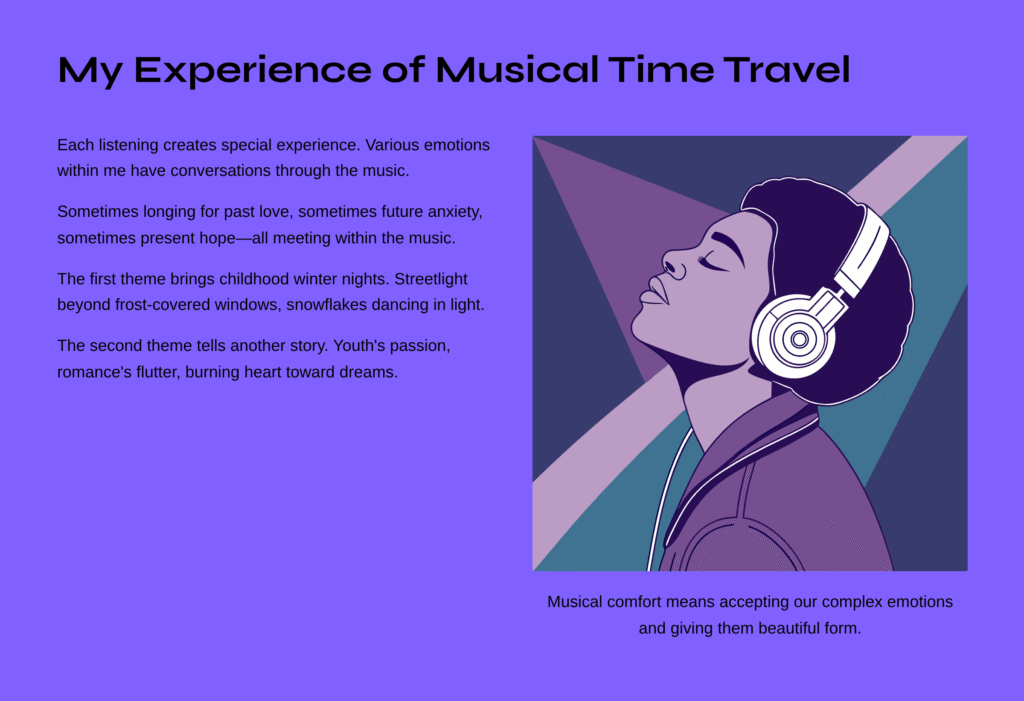
My Experience of Musical Time Travel
Each time I listen to this piece, I have a special experience. It’s as if the various emotions within me are having a conversation. Sometimes it’s longing for past love, sometimes anxiety about the future, and sometimes hope for living in the present—all meeting within the music.
Particularly when the first theme flows out, I always think of winter nights from my childhood. The streetlight glowing beyond frost-covered windows, and snowflakes dancing in that light. The quietude and beauty of those moments seem to be dissolved completely within this melody.
The second theme tells another story. The passion of youth, the flutter of romance, the burning heart toward dreams. All of these dance within the brilliant harmonies. And by the time the piece ends, I somehow feel more mature.
Isn’t this what musical comfort truly means? Accepting our complex emotions as they are and giving them beautiful form.
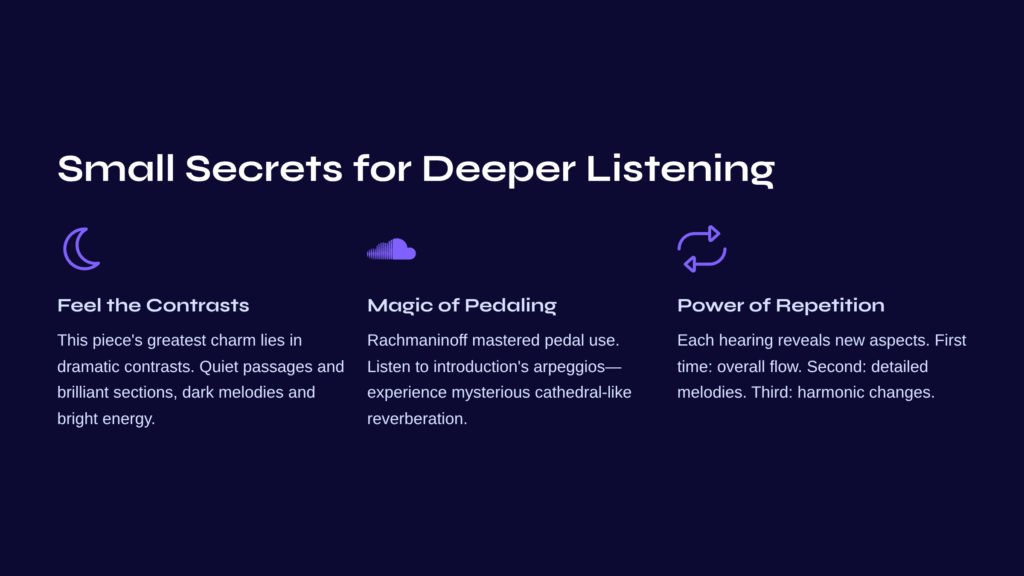
Small Secrets for Deeper Listening
I’d like to share a few tips for experiencing this piece more richly.
First, pay attention to the contrasts. This piece’s greatest charm lies in its dramatic contrasts. Quiet passages and brilliant sections, dark melodies and bright rhythmic energy. By consciously feeling these contrasts while listening, the piece’s structure becomes much clearer.
Second, feel the magic of pedaling. Rachmaninoff was a master of pedal use. Particularly when listening to the introduction’s arpeggios, pay attention to the resonance created by the pedal. You’ll experience a mysterious sound quality like the reverberation in a cathedral.
Third, trust in the power of repeated listening. This piece reveals new aspects with each hearing. Listen for the overall flow the first time, detailed melodies the second time, and harmonic changes the third time. Each listening will bring new discoveries.
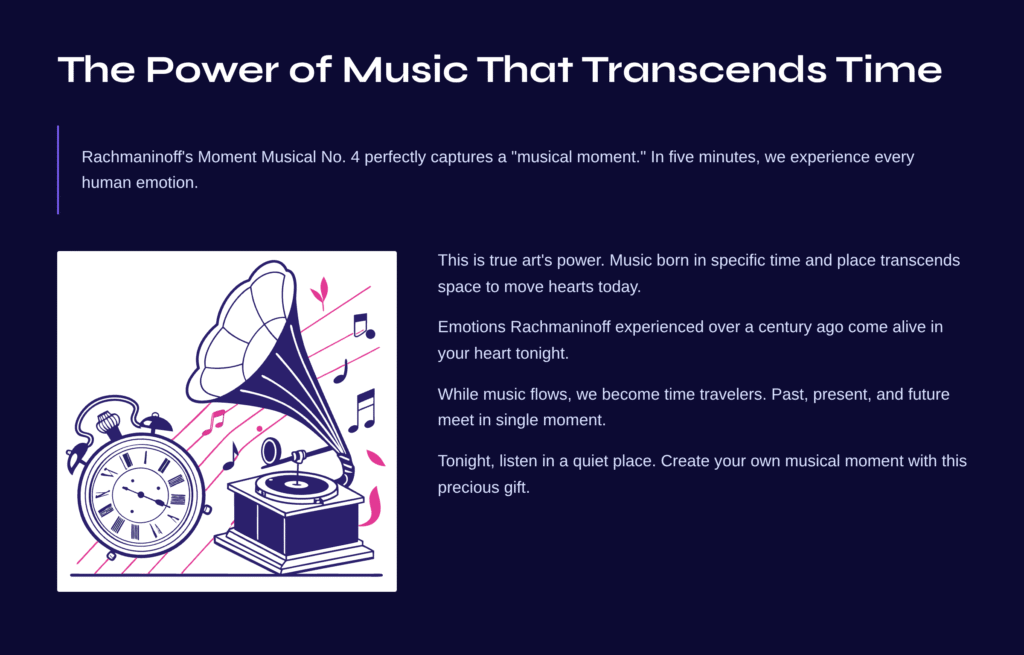
The Power of Music That Transcends Time
Rachmaninoff’s Moment Musical No. 4 is a work that perfectly captures what its title suggests—a “musical moment.” In just about five minutes, we experience every emotion of human life. And that experience never fades with time.
Isn’t this precisely the power of true art? That music born in a specific time and place can transcend space and time to move the hearts of those living today. That emotions Rachmaninoff experienced over a century ago can come alive again in your heart tonight.
While music flows, we all become time travelers. We experience the magic where past, present, and future meet in a single moment. And even after that magic ends, something new remains within us.
Tonight, listen to this piece in a quiet place. Create your own musical moment. This precious gift that Rachmaninoff left behind will surely approach you with special meaning.
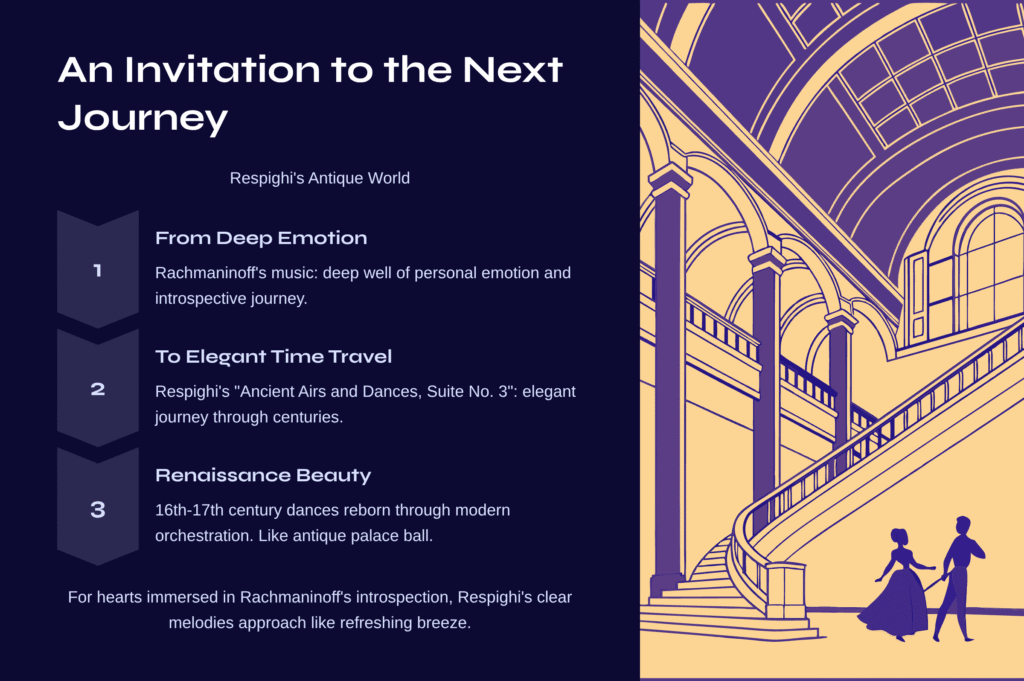
An Invitation to the Next Journey – Respighi’s Antique World
After completing this deep emotional journey with Rachmaninoff, how about departing for a musical world of completely different colors? Ottorino Respighi’s “Ancient Airs and Dances, Suite No. 3” provides a perfect contrast in this sense.
If Rachmaninoff’s music is a deep well of personal emotion, then Respighi’s work is an elegant time travel back through the centuries. This suite, which rebirths 16th and 17th-century Renaissance and Baroque dances through modern orchestration, evokes a ball held in an antique palace.
Especially for hearts that have been immersed in Rachmaninoff’s introspective emotions, Respighi’s clear and elegant melodies will approach like a refreshing breeze. It will offer another musical moment—experiencing beauty created by history and tradition that transcends personal emotion.
